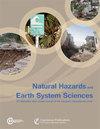The influence of large woody debris on post-wildfire debris flow sediment storage
IF 4.7
2区 地球科学
Q1 GEOSCIENCES, MULTIDISCIPLINARY
引用次数: 0
Abstract
Abstract. Debris flows transport large quantities of water and granular material, such as sediment and wood, and this mixture can have devastating effects on life and infrastructure. The proportion of large woody debris (LWD) incorporated into debris flows can be enhanced in forested areas recently burned by wildfire because wood recruitment into channels accelerates in burned forests. In this study, using four small watersheds in the Gila National Forest, New Mexico, which burned in the 2020 Tadpole Fire, we explored new approaches to estimate debris flow velocity based on LWD characteristics and the role of LWD in debris flow volume retention. To understand debris flow volume model predictions, we examined two models for debris flow volume estimation: (1) the current volume prediction model used in US Geological Survey debris flow hazard assessments and (2) a regional model developed to predict the sediment yield associated with debris-laden flows. We found that the regional model better matched the magnitude of the observed sediment at the terminal fan, indicating the utility of regionally calibrated parameters for debris flow volume prediction. However, large wood created sediment storage upstream from the terminal fan, and this volume was of the same magnitude as the total debris flow volume stored at the terminal fans. Using field and lidar data we found that sediment retention by LWD is largely controlled by channel reach slope and a ratio of LWD length to channel width between 0.25 and 1. Finally, we demonstrated a method for estimating debris flow velocity based on estimates of the critical velocity required to break wood, which can be used in future field studies to estimate minimum debris flow velocity values.大型木屑对野火后泥石流泥沙蓄积的影响
摘要泥石流携带了大量的水和颗粒状物质,如沉积物和木材,这种混合物会对生命和基础设施造成毁灭性的影响。在最近被野火烧毁的森林地区,大型木质碎屑(LWD)纳入泥石流的比例可能会增加,因为在被烧毁的森林中,木材进入通道的速度会加快。在这项研究中,我们利用新墨西哥州吉拉国家森林的四个小流域,在2020年蝌蚪大火中燃烧,探索了基于随钻测井特征和随钻测井在泥石流体积保留中的作用来估计泥石流速度的新方法。为了理解泥石流体积模型的预测,我们研究了泥石流体积估计的两种模型:(1)目前用于美国地质调查局泥石流危害评估的体积预测模型;(2)用于预测与碎屑流相关的产沙量的区域模型。我们发现,区域模型与终端扇观测到的泥沙量更匹配,表明区域校准参数在泥石流体积预测中的实用性。然而,大型木材在终端扇上游形成泥沙储存,其体积与终端扇储存的总泥石流体积大小相同。利用现场和激光雷达数据,我们发现随钻储沙在很大程度上受河道坡度和随钻长度与河道宽度之比在0.25到1之间的控制。最后,我们展示了一种基于劈裂木材所需临界速度估计泥石流速度的方法,该方法可用于未来的实地研究,以估计最小泥石流速度值。
本文章由计算机程序翻译,如有差异,请以英文原文为准。
求助全文
约1分钟内获得全文
求助全文
来源期刊
CiteScore
7.60
自引率
6.50%
发文量
192
审稿时长
3.8 months
期刊介绍:
Natural Hazards and Earth System Sciences (NHESS) is an interdisciplinary and international journal dedicated to the public discussion and open-access publication of high-quality studies and original research on natural hazards and their consequences. Embracing a holistic Earth system science approach, NHESS serves a wide and diverse community of research scientists, practitioners, and decision makers concerned with detection of natural hazards, monitoring and modelling, vulnerability and risk assessment, and the design and implementation of mitigation and adaptation strategies, including economical, societal, and educational aspects.

 求助内容:
求助内容: 应助结果提醒方式:
应助结果提醒方式:


